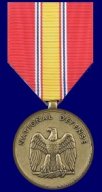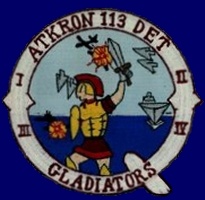|
VA-113 DET-Q    March 22, 1965 - October 7, 1965 |
 |
|
VA-113 DET-Q    March 22, 1965 - October 7, 1965 |
 |
My
short story: by LEUT Phil Thompson
"A-4G Catshot HMAS Melbourne For most of the A4G Skyhawk and S2E/G Tracker era, HMAS Melbourne used a steam catapult rebuilt mostly from parts bought from the Royal Canadian Navy after its last carrier, HMCS Bonaventure, paid off in July 1970. While the precise length of that system remains unclear, a VF-805 pilot from Melbourne's last cruise with embarked A4Gs recalls being advised that the stroke within was 90-100 feet. Reliable flight deck crew and shipyard sources state that the cat was built in sections eight feet long. There was a pre-Bonaventure suggestion to lengthen Melbournes bow so as to install two more sections. However, the Navy Office boffins calculated that the bow could not support the extra load, and no changes were made until the Canadian system became available. The Bonaventures cat was a newbuild, as she had undergone a recent and very extensive refit to prolong her service life for another planned, and subsequently canceled, five years. In the absence of a verifiable figure, it seems reasonable to estimate the overall cat length at between 100 and 110 feet. An A4G launching from HMAS Melbourne was catapulted to the end of the track in one to 1.5 seconds. Pilot testimony differs in this figure. The cat had an inconsistency but it worked out to an end speed of approximately 115 knots groundspeed, relative to the ship, although at least one pilot recalls this routinely being a higher speed. Add the speed of Wind Over Deck (WOD) and you have a flying speed of 140 knots if the WOD is 25 knots. The WOD consists of ship speed into wind and the natural wind itself coming over the flight deck. It was calculated that 25 knots WOD was ideal, although this required at least three knots of natural wind and the Melbourne to rattle-and-hum her way to maximum speed of 22 knots. She was not always capable of this. To my recollection, the A4G setting for the catapult was always the same, as long as the specified flying speed was adequate for weight and conditions. This was regardless of the aircrafts All Up Weight (AUW). In tropical waters high temperatures and nil wind were prevalent, and the whole launch dynamic required more than usual finessing of aircraft AUW. In this case the AUW was reduced, or the ship would go searching for natural wind. In calm conditions wind lanes are visible at a distance so the ship would steam full speed for them and hope the WOD would be sufficient. Having the same whack meant that low weight launches were a physical shock. The low AUW aircraft end speed would be much higher than a more normal weight launch. Low AUW launches were standard during deck landing qualifications, when the aircraft would arrest at low landing arrest weight and then immediately launch at that low (maximum arrest) weight. The physical effect of a pilots first catshot was literally breathtaking (similar to a thump in the chest with a closed fist). The A4G was stressed longitudinally to 9 Gs. Pilots were told to allow for the stresses of the catshot. One pilot recalls that in peacetime this was limited to 5.5 G. Simple physics equations show that length, time and end speed were optimized for launch at about 6 G. However, due to reductions in projected airframe life that constant 6 G catshots would have caused, this was restricted to war only launches. An untamed steam catapult could break anything, but the power was always controlled by procedures and machinery. The tamed cat was fired by an NCO at his control station inside the howdah, who took his instruction from the cat officer on deck via hand signals. If any devices failed or correct operating procedures were not followed by the cat team, then a cold cat was possible, with disastrous consequences for aircraft and aircrew. Also, if the holdback mechanism failed with the aircraft at full military power and no catapult thrust, then the aircraft could neither reach flying speed nor could it brake to a halt on the slippery 100 feet of deck in front of it. Zero-Zero ejection seats were, and are, good for this situation! I heard stories of RAN A4Gs being cross-decked with HM ships Eagle and Hermes during their final cruises to Australian waters in the late 1960s and early 1970s. Those ships longer cats created a lot of excess airspeed for the A4G at the end of the shot there was a limit to how much the cat itself could be throttled back for the Skyhawk. Thus, for low AUW aircraft long catapults built for heavier aircraft were slightly problematic. Generally the Melbourne catapult was adequate except in certain circumstances as outlined. A heavy AUW A4G shot in minimal launch conditions would rotate off the catapult but do nothing much for a few seconds whilst it gathered independent flying speed. At the other extreme, in some videos it is possible to see the low AUW A4G leap into the air off the cat track. In heavy seas a launch had to be timed so that the cat was fired as the bow started to rise on the swell. The optimum position for the bow was with the stern at maximum rise and starting down. Simply, the bow had to be moving upwards. Being launched while the bow was going down into the swell was not something to contemplate for the few seconds between saluting the Flight Deck Officer and the actual catshot. There was a stated delay of 1.25 seconds between the howdah engineer pushing the button and the cat firing, and the cat officer had to allow for this in his final signal. The RAN used Royal Navy signals for flight deck procedures, and the signal for launch go was to end the wind-up, bend down and touch the deck. Sometimes the shot delay was longer than a few seconds, for one of a multitude of reasons. The A4G rotated naturally to the correct angle of attack off the catapult by the pilot allowing the stick to come back into his stomach we held our hand there to catch the stick while holding on to a launch bar and throttle to ensure that the throttle did not reduce during launch. There is at least one story of an A4G being launched into the swell such that the wheels skimmed the sea surface for a few seconds. In this scenario the A4G would have been in the ground effect air cushion, being the interaction of wings with the water surface." About
LEUT Phillip James Thompson RAN
Huge RAN Archive Over the past few years Phil has been making a 4.4GB PDF about the Royal Australian Navy (RAN), Fleet Air Arm (FAA) A4Gs and their Fixed Wing aircraft (now only helos remain). The Download sites below have PDFs and videos about deck ops. New
URLs:
|
|
Collection
of A4 and Flying Videos
Recent
collection of A4G Ops aboard HMAS Melbourne Video Clips made in the era
1969 to early 1970s (perhaps just 1969-70). One cool clip is a deck view
of two A4Gs firstly doing touch and goes and then arrests in SLOW MOTION.
Phil
Thompson (ex-RAN A4G pilot)
Recent
AWM A4G (+ others) OPS Aboard HMAS Melbourne Early 1970s
You'll
see A4G slow motion arrest and the operation of the strop catcher amongst
many other RAN Aircraft Ops onboard HMAS Melbourne in this 'showreel' (of
all the others below) compilation clip video:
http://www.awm.gov.au/blog/category/collection/ http://www.awm.gov.au/blog/2013/08/30/film...common-carrier/ Film Collection Online: Not a Common Carrier
Friday
30 August 2013 by Daniel Eisenberg.
To
complement the release of the film collection online, the film and sound
team are creating a series of showreels to give you a taste of the material
that is now readily available at your fingertips!
Recent
additions to the film available on line include material from the Royal
Australian Navy (RAN) Public Relations unit. This compile of selected clips
focuses on the former flagship of the RAN, HMAS Melbourne, and on carrier
operations with the Navys Fleet Air Arm from 1960 until 1980. Aircraft
are shown being moved into position and taking off with the aid of the
ships steam catapult. However this system did not work faultlessly- as
can be seen in the clip. Various shots of planes landing show how it was
possible to slow a planes momentum in a confined area. Views of the flight
deck of HMAS Melbourne give an impression of the activities of the sailors
and aviators who worked to keep the navys aeroplanes flying. Planes seen
include: Sea Venoms, Gannets, Skyhawks, Trackers and Wessex helicopters.
The soundtrack comes from a number of Navy PR newsreels from the 1960s
called Navy in Focus. Sound effects are from Douglas A-4 Skyhawk - operational
sounds (S04698) an actuality recording held in The Australian War Memorials
collection.
Please enjoy exploring, researching and, most importantly, viewing our collection. Links to collection items used in this showreel: - " http://www.awm.gov.au/collection/S04698/- A4G sounds only - does not appear to be any download? http://www.awm.gov.au/collection/F04986/- Loss of A4G 889 due catapult failure - pilot OK http://www.awm.gov.au/collection/F04987/- A4Gs + S2Es Slow Motion Arrests & Cats http://www.awm.gov.au/collection/F10727/ - A4Gs + S2Es 1968 http://www.awm.gov.au/collection/F10956/- A4Gs/S2Es Arrest - Side View A4G Arrest http://www.awm.gov.au/collection/F10964/- 1969 S2E Workup MELBOURNE Cats/Arrests see the CCA [GCA] uncovered http://www.awm.gov.au/collection/F10978/- A sort of a pilot view from unknown aircraft {S2?} of a Carrier Approach http://www.awm.gov.au/collection/F10982/- Aerial Views from Helo Over HMAS Melbourne - Iroquois seen on deck aft http://www.awm.gov.au/collection/F10986/- 1972 SEATO Ex. F-5s? FlyBy A4Gs arrest/cat http://www.awm.gov.au/collection/F10995/- Colour S2E Arrest only http://www.awm.gov.au/collection/F11252/- 1970 Pair A4Gs Nullarbor Express Nowra/Perth MELBOURNE arrest, CO VF-805 [884] LCDR Col Patterson + LEUT Ken Palmer [889] http://www.awm.gov.au/collection/F11253/- A4G Armament Demo MELBOURNE Rockets/Bombs Catapults http://www.awm.gov.au/collection/F11268/- Colour A4G Arrests Cats 1969 FDO LCDR Patterson (Catapult O) mid 1970-2 CO VF-805 http://www.awm.gov.au/collection/F11265/-
Trackers and Skyhawks commissioned 10 Jan 1968
|
|
When Va-113 Det Q returned to the United States, it disbanded and merged
with Antisubmarine
Warfare Fighter Squadron One (VSF-1).
The newly formed Squadron was stationed at Naval Air Station Alameda on the beautiful San Francisco Bay. |
| Site
Search
|
Support
the NAS Alameda Naval Air Museum and the USS Hornet Museum
bswanson7@sbcglobal.net
|